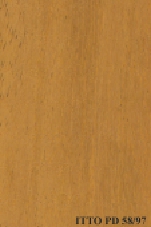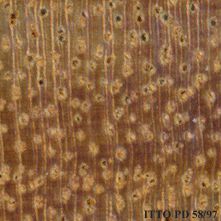
ACAJOU D`AFRIQUE (Khaya anthotheca)
Trade Name
Acajou d`Afrique
Scientific Name
Khaya anthotheca C.DC.
Family
MELIACEAE
Common Names
Krala (Côte d`Ivoire); Ira (Côte d`Ivoire); Acajou sassandra (Côte d`Ivoire); Acajou Krala (Côte d`Ivoire); Acajou blanc (Côte d`Ivoire); African Mahogany (United Kingdom); N'Dola (Congo); N'Dola (Angola); White mahogany; Uganda mahogany; Smooth barked African mahogany; Red mahogany; Ogwango nofuwa; Ogigedu; Odupon; Ngollon; Mpohe; Lra; Lpaki; Lagos wood; Kwantannuro; Kwabohoro; Kwabohori; Kwabaho; Krumben; Kruba; Krala; Kirumbo; Khaya; Heavy African mahogany; Funfun; Dukuma-fufu; Diala; Bie-eh-nasa; Benin wood; Arwabotioro; Anthotheca; Akwantannuro; Ahafo timber; Ahafo mahogany; African mahogany; Acajou mangora; Acajou krala; Ogwango (Nigeria); Dukuma fufu (Ghana); Dubini (Ghana); Acajou d`Afrique (Côte d`Ivoire); Khaya mahogany (Germany); Acajou blanc (France); N`dola N`dola (Angola); Munyama (Uganda); N`dola N`dola (Congo); Mangona (Cameroon); Ahafo (Ghana); Acajou krala Acajou krala (Côte d`Ivoire)
Scientific Name Synonyms
Khaya mildbraedii Harms; Khaya euryphylla Harms; Khaya agboensis A. Chev.; Garretia anthotheca Welw.
Description Of The Tree
Botanical Description
The tree reaches a height of more than 50 m. The bole is usually straight, clear and cylindrical to 30 m in length, buttressed. The trunk diameter is up to 120 cm. Log is banned for international trading.(Cameroon)
Natural Habitat
Khaya anthotheca occurs in the intermediate zone between moist coastal and drier interior zones. It grows best in deep fertile soils on riverbanks. National conservation status in Cote d`Ivoire V, Liberia E, Uganda V/nt.
Natural Distribution
From Sierra Leone and Liberia to Gabon, it extends eastward to Uganda.
Plantations Available?
Tested and planted in some African countries. In most cases, mixed plantations with other species (Niangon, Okoume, Bilinga). The duration of the rotation is 40 years, to reach 60 cm in diameter.
Wood Identification
Anatomic Description Of Wood
Wood diffuse porous. Occasionally vessels exclusively solitary (over 90%). Tangential diameter of vessel lumina 200 micras or more (large). Brown-colored deposits in heartwood vessels. Non-vestured pits. Vessels per mm2 6 to 10 (medium). Simple perforation plat Occasionally axial parenchyma in marginal or in seemingly marginal bands. Paratracheal axial parenchyma scanty and/or vasicentric. Occasionally prismatic crystals in non-chambered axial parenchyma cells. 3 to 4 cells per parenchyma strand. 4 to 10 rays per mm (medium). Rays of two distinct sizes. Occasionally rays storied. Rays 1 to 2 seriate. Larger rays more than 4 seriate. Body ray cells procumbent with mostly 2 to 4 rows of upright and/or square marginal cells (Kribs-II). Septate fibers present. Fibers with simple to minutely bordered pits.
-
 Wood Macro Photo Tangential Plane
Wood Macro Photo Tangential Plane
-
 Wood Micro Photo Of Transversal Section
Wood Micro Photo Of Transversal Section
Availability
Cites Status
Unrestricted
General Wood Description
Odor
Light and pleasant odor.
Color
The sapwood is creamy white to yellowish white, it has a thickness of 5 cm. The heartwood is pink to light red brown, it is clearly demarcated. The silver figure is fine.
COLOR INDEX (1=Black, 7=Light yellow,white)
4
Grain
The grain is slightly but systematically interlocked.
Texture
The wood is typically medium in texture.
Luster
This wood is frequently low in luster.
Natural Durability
Moderately durable to decay. Without preservative treatment, this species can be used only under risk of occasional re-humidification. It is not suited for uses with risks of permanent or long-lasting humidification. Sensible to termites attack. The heart
Natural durability index (1= Very high durability, 7=Vey low durability)
3
Internal Growth Stresses
Residual stresses are reported to be absent.
Resistance To Impregnation
Nearly impossible to treat with a too much low penetration of the preservative substances.
Wood Physical Properties
Basic Density or Specific Gravity (O.D. weight/vol. green) (g/cm³)
0.55
Air-dry Density (Weight and volume at 12%MC) (g/cm³)
0.61
Total shrinkage Tangential (Saturated to 0%MC) (%)
5.5
Total shrinkage Radial (Saturated to 0%MC) (%)
3.7
Drying Defects
Ease of Drying: Air drying is good. It takes respectively 2 months and 5 months to air dry boards of 13 mm and 38 mm thick. Drying Defects: Risk of end-splitting and surface checking.
Recommended Dry Kiln Schedule
FR-6
Dimensional stability ratio (Total Tangential Shrinkage %/Total Radial Shrinkage %)
1.5
Wood Chemical Properties
Wood Mechanical Properties
Bending Strength (MOR),12%MC (kgf/cm²)
850
Stiffness (MOE) 12%MC (kgf/cm²)
94245
Compression parallel to fiber 12%MC (kgf/cm²)
495
Compression perpendicular to fiber 12%MC (kgf/cm²)
61
Shear strength radial 12%MC (kgf/cm²)
84
Janka hardness (side) 12%MC (kgf)
454
Janka hardness (end grain) 12%MC (kgf)
558
Workability
Sawing
It is easy to saw.
Rotary Veneer Cutting
Suitable for slicing, also suitable for peeling if treated.
Sliced Veneer
Suitable for slicing, also suitable for peeling if treated.
Blunting Effect
Slight blunting effect; ordinary tools can be used for sawing and machining.
Machining
Machining of this species is reportedly easy.
Planing
Easy; no particular problems.
Moulding
Moderately easy; tools must be cautiously sharpened.
Turning
30
Boring
Moderately easy; tools must be cautiously sharpened.
Mortising
Moderately easy; tools must be cautiously sharpened.
Nailing
No particular problem.
Gluing
Glues well if basic gluing technical rules are followed.
Sanding
Easy to perform; it gives good results.
Polishing
Can be polished without surface preparation.
Steam Bending
Steam bending is difficult.
Response To Hand Tools
No particular problems.
REFERENCED USES
End Uses Summary
HOUSING GENERAL, beams, joists, boards, frames, steps, panelling, fittings, FURNITURE AND CABINETS, luxury furniture, cabinets, PLYWOOD AND VENEER, faces, Decorative veneer, TURNING, ornaments, turned furniture, NAVAL CONSTRUCTION, boats, boat hulls, boat deck, port storage
General Housing
- 10 - Silica in Timbers
Beams
- 11 - Prospect: The wood database
Joists
- 12 - Tropical timbers of the world. Part I-Tropical American Species
Boards
- 13 - Dry kiln schedules for commercial woods. Temperate and tropical. Section III. Latin American (Mexico, Central, and South America) Woods–Conventional Temperatures
Frames
- 16 - Woods of the World
Steps
- 17 - Tree Conservation Database
Paneling
- 18 - W3TROPICOS Missouri Botanical Garden
Fittings
- 19 - Silica in Timbers
Furniture Cabinets
- 21 - Tropical timbers of the world. Part III-Southeast Asian and Oceanian Species.
Furniture, Luxury
- 22 - Dry kiln schedules for commercial woods. Temperate and tropical. Section IV-Asian and Oceanian Woods
Cabinet
- 24 - Empire Timbers
Panels, Veneers
- 25 - Directory of Timber Trade Malaysia
Faces
- 26 - Annual Review and Assessment of the World Timber Situation 1998-ITTO
Decorative veneer
- 28 - Ministry of Agriculture, Fisheries & Forest of Fiji
Turning
- 30 - Embassy of Honduras in Japan
Ornaments
- 31 - Embassy of Colombia in Japan
Turned Articles
- 32 - Embassy of Cote d`Ivoire in Japan
Shipbuilding
- 55 - Tropical Timber Atlas of Latin America
Boats
- 56 - Manual de Identificación de Especies Forestales de la Subregión Andina.
Boat Hulls
- 57 - Estadísticas de Aprovechamiento, Exportación y comercialización Nacional de Productos Forestales
Boat Decking
- 59 - Programa Nacional de uso Sostenible de los Bosques e Incremento a las Exportaciones.
Port Storage
- 62 - Estudio Tecnológico de Maderas del Perú (Zona Pucallpa) Vol I
Please Provide Information To View Producer Information